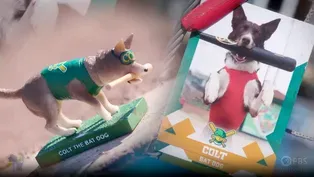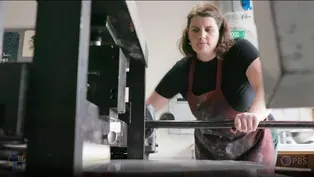
Mine Museum
Clip: Season 10 Episode 1 | 4m 42sVideo has Closed Captions
Artist Heidi Dyas-McBeth draws inspiration from the wonders of Mother Nature underground.
Heidi Dyas-McBeth is an artist who draws inspiration from the wonders of Mother Nature underground. She’s a tour guide at the Bevans Mine in Platteville where she also does mosaic art.
Problems with Closed Captions? Closed Captioning Feedback
Problems with Closed Captions? Closed Captioning Feedback
Wisconsin Life is a local public television program presented by PBS Wisconsin
Funding for Wisconsin Life is provided by the Wooden Nickel Fund, Mary and Lowell Peterson, A.C.V. and Mary Elston Family, Obrodovich Family Foundation, Stanley J. Cottrill Fund, Alliant Energy, UW...

Mine Museum
Clip: Season 10 Episode 1 | 4m 42sVideo has Closed Captions
Heidi Dyas-McBeth is an artist who draws inspiration from the wonders of Mother Nature underground. She’s a tour guide at the Bevans Mine in Platteville where she also does mosaic art.
Problems with Closed Captions? Closed Captioning Feedback
How to Watch Wisconsin Life
Wisconsin Life is available to stream on pbs.org and the free PBS App, available on iPhone, Apple TV, Android TV, Android smartphones, Amazon Fire TV, Amazon Fire Tablet, Roku, Samsung Smart TV, and Vizio.
Providing Support for PBS.org
Learn Moreabout PBS online sponsorship♪ ♪ There's a balance in nature [dog barks] that intrigues Heidi Dyas-McBeth.
- When we first came to Platteville, I was doing a lot of mosaic artwork.
Yeah, she's called the "“queen of the compost,"” [birds singing] hence her siting by the compost pile.
She's got on her version of her overalls.
I'm just now kind of dabbling a little bit with using materials from this area in my mosaic artwork.
- Heidi is working in mixed media of sorts... art and mining.
- I started at the mine in 2020.
Welcome to the Mining and Rollo Jamison Museum.
My name is Heidi, and I'm going to be your tour guide today.
- The old Bevans mine in Grant County opened a new world to explore, painting a new perspective for Heidi's mosaic art.
- The 'aha moment' was there's a lot going down underneath the ground, and this is the thing that kind of blows my mind.
And it's been going on for billions of years.
This area was covered by a shallow sea.
This is a marine coral.
It's got that pattern like a sunflower on the top of it.
- Miners discovered the fossils centuries ago while tunneling under southwest Wisconsin.
- When we go into the mine, we're actually going to go down 90 stairs.
- Each step of Heidi's tours are steeped in history.
- We're walking down through time now.
We're walking down through those various layers.
You'll slowly start to feel the temperature get a little bit colder and it's going to feel somewhere between 50° and 60°.
You are basically in just kind of a dome of dolomitic rock when you're down there.
We're going to be 50 to 60 feet below ground at that point, which would be typical for kind of underground lead mines during the 1840s.
- For Heidi, the mine tour evokes a sense of community, a sense of place, and a sense of the past.
- The side of receptaculitids.
I think one of the things that's unique is that we're still able to get a glimpse of the past.
I want them to pick up on how important the mining in this area was to the formation of our community here.
- A history that is tied to a tether reaching into the past 400 years.
- As far back as the 1600s, Native Americans would have been mining for lead.
They were mining for galena.
That's the primary lead ore that could be found near the surface.
They would have made little molds to make little medallions, and they referred to those as 'platte.'
I believe that is how Platteville got its name.
- A discovery by Indigenous People is still leaving its mark on this land.
- This is galena.
They referred to this as 'gray gold' because once we get up to about the 1820s, there was a lead rush in this area, with miners coming in because they were realizing there was an abundance of this mineral here.
- Nature formed the minerals into a patchwork of watercolored art.
- It's very drippy down here today.
This is dolomitic stone down here.
So, this is where those fossils and the minerals that we talked about up above were found.
If anybody would like to peek into one of these bear holes, that would have been more like the size of the shaft that the miners would have been working in.
We're going to be heading into the main drift, which is the main vein of lead that runs through the mine.
- Like a vein running through the mine, those minerals now run through Heidi's art like a metaphor for her mosaics.
- I've got a nice little vein of that dolomitic limestone through there.
There's my little galena shining down in there.
As I learned more about some of the geology of this area, that's definitely playing a big part in the way that I think about my artwork, in terms of just layering of things.
I think that's typical for artists.
As you learn new things, you start to pull those things in.
Kind of crazy with some beehive patterns.
They had a bell system, where they could send a signal up to the hoist operator.
[clanging] I really do enjoy doing the mining tours.
I do get really passionate about this and with art.
- Inspired by Mother Earth, the elements in both Heidi's art mosaics and mine tours are billions of years in the making.
[applause] - Thank you for coming on a tour.
[applause]
Video has Closed Captions
Colt and Kovu are high-flying bat dogs made famous at Madison Mallard baseball games. (3m 57s)
Video has Closed Captions
Geo Rutherford is an explorer unraveling the Great Lakes’ mysteries with science and art. (5m 37s)
Providing Support for PBS.org
Learn Moreabout PBS online sponsorshipSupport for PBS provided by:
Wisconsin Life is a local public television program presented by PBS Wisconsin
Funding for Wisconsin Life is provided by the Wooden Nickel Fund, Mary and Lowell Peterson, A.C.V. and Mary Elston Family, Obrodovich Family Foundation, Stanley J. Cottrill Fund, Alliant Energy, UW...













